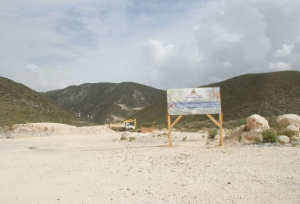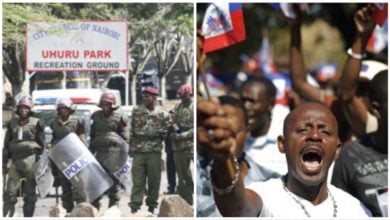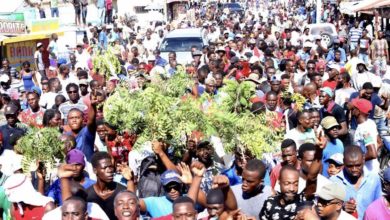
Haiti’s ‘Reception Center for Returnees’ at Malpasse consists of this flimsy plywood hut on several acres of bleached white gravel. Photo: Milo Milfort/Haïti Liberté
Malpasse, Haiti, Jun. 23, 2015—”To facilitate the process, we hope that the crossings [deportation points] are at Malpasse and Ouanaminthe,” said Haiti’s Communication Minister Rothchild François Jr. on Friday, June 19, 2015.
“The Contingency Plan which was being prepared is ready and functioning,” said the government spokesman.
In May 2015, the Defense Ministry announced the Contingency Plan to receive undocumented Haitians who were to be deported from the neighboring Dominican Republic starting in June.
Two receiving locations had been planned to accommodate the stateless persons from the Dominican Republic, François said.
The repatriations had in fact already started at Malpasse. The government was aware of them. “We received [on June 19] at Malpasse 23 people who are in fact returnees,” said Ariel Henri, Haiti’s Interior Minister.
Yet at Malpasse, nothing is ready.
Along the border road leading from Jimani to Croix des Bouquets near Port-au-Prince, there is a large empty expanse of gravel and sand. On it are two dump trucks, a backhoe, a steam shovel, a Haitian flag, a plastic tent, and a mobile toilet. This is where the deportees are to be received.
At the entrance to the lot, a sign says: “Republic of Haiti. Ministry of Defense. Corps of Military Engineering.” Below it, alongside the Defense Ministry logo, it reads in larger letters: “Reception Center for Returnees.”
Some goats, a dog, and a female visitor are keeping company the three members of the Corps of Engineers on hand.
Under the soldiers’ shirts, one can see a gray T-shirt with “Ministry of Defense” printed on it. They also wear boots and multi-pocket blue pants.
“In the face of duty” is the phrase at the bottom of the sign behind which the soldiers are stationed. But what duty is the sign talking about? Is there truly a Welcome Center?
“There’s nothing here,” says a member of the Corps of Engineers, sitting with another in a rudimentary temporary plywood shelter in the middle of this wasteland to escape the hot sun. “We are not ready yet.”
From afar, one might mistakenly think that the brand new houses of the Haitian Customs nearby were those built to receive the deportees.
“If they send returnees here, only the President will know what to do with them,” the soldier adds. “We are just here to watch over the equipment.”
The organizations which defend migrants’ rights like the Support Group for the Repatriated and Refugees (GARR) has come to the same conclusion.
“We made many visits and we saw nothing,” lamented Josué Michel, a GARR communications assistant reached by telephone. “Nothing serious has been put in place.”
“Until now, the authorities are only dragging their feet in figuring out how to receive people,” he complained.
The repatriation of undocumented Haitians and Dominicans of Haitian descent began with the beginning of the National Plan for Dominican Regularization on June 17, 2015.






